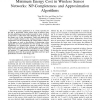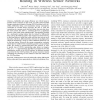INFOCOM
2012
IEEE
12 years 1 months ago
2012
IEEE
—In many applications, it is a basic operation for the sink to periodically collect reports from all sensors. Since the data gathering process usually proceeds for many rounds, i...
INFOCOM
2012
IEEE
12 years 1 months ago
2012
IEEE
—Developing simple distributed algorithms to allow nodes to perform topology discovery and message routing using incomplete topological information is a problem of great interest...
INFOCOM
2012
IEEE
12 years 1 months ago
2012
IEEE
—In this paper we present a methodology for the design of congestion control protocols for background data transfers that have a minimal delay impact on short TCP transfers and c...
INFOCOM
2012
IEEE
12 years 1 months ago
2012
IEEE
Abstract—Network power consumption can be reduced considerably by adapting link data rates to their offered traffic loads. In this paper, we exploit how to leverage rate adaptat...
INFOCOM
2012
IEEE
12 years 1 months ago
2012
IEEE
Abstract—This paper considers a novel distributed system for collaborative location-based information generation and sharing which become increasingly popular due to the explosiv...
INFOCOM
2012
IEEE
12 years 1 months ago
2012
IEEE
Abstract—In this paper, we implement and evaluate three different Byzantine Fault-Tolerant (BFT) state machine replication protocols for data centers: (1) BASIC: The classic solu...
INFOCOM
2012
IEEE
12 years 1 months ago
2012
IEEE
— Reliability and energy efficiency are critical issues in wireless sensor networks. In this work, we study Delay-bounded Energy-constrained Adaptive Routing (DEAR) problem with...
INFOCOM
2012
IEEE
12 years 1 months ago
2012
IEEE
—In today’s Internet, online social networks (OSNs) play an important role in informing users about content. At the same time, mobile devices provide ubiquitous access to this ...
INFOCOM
2012
IEEE
12 years 1 months ago
2012
IEEE
—Reactive jamming is not only cost effective, but also hard to track and remove due to its intermittent jamming behaviors. Frequency Hopping Spread Spectrum (FHSS) and Direct Seq...
INFOCOM
2012
IEEE
12 years 1 months ago
2012
IEEE
—Thorup-Zwick (TZ) compact routing guarantees sublinear state growth with the size of the network by routing via landmarks and incurring some path stretch. It uses a pseudo-rando...


